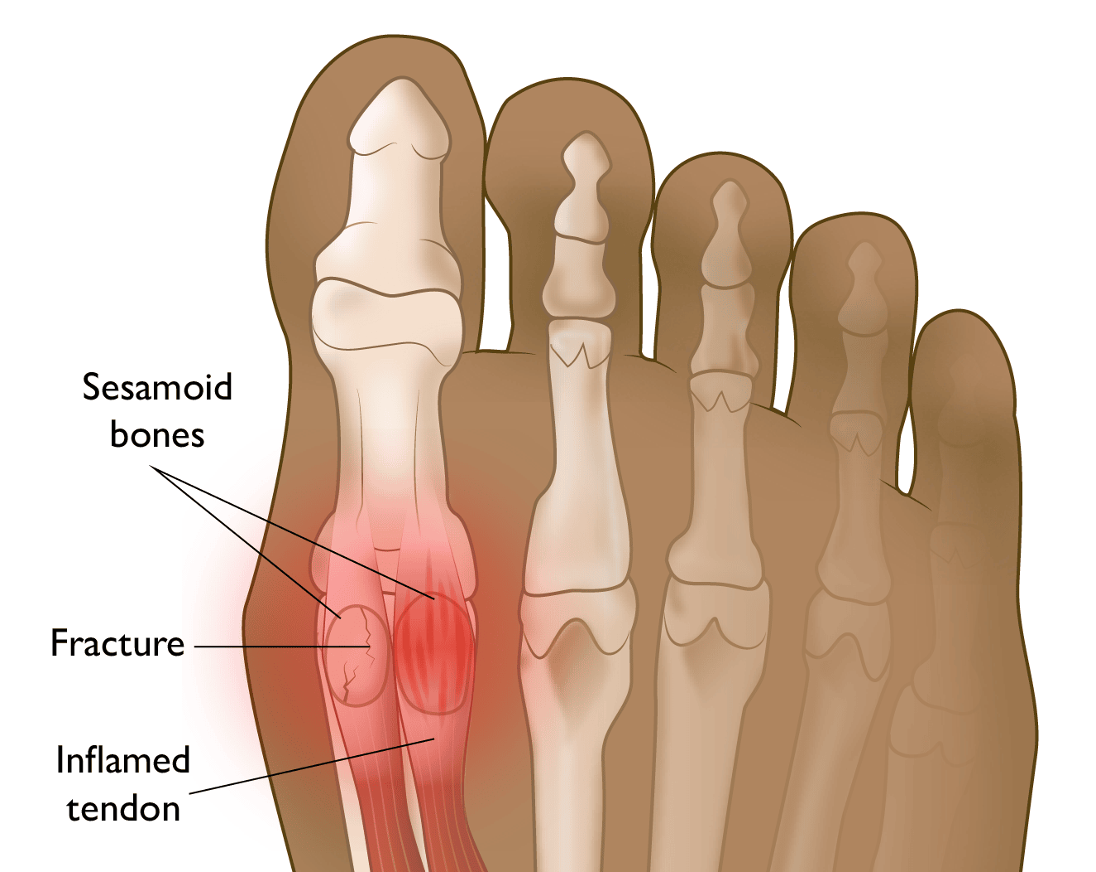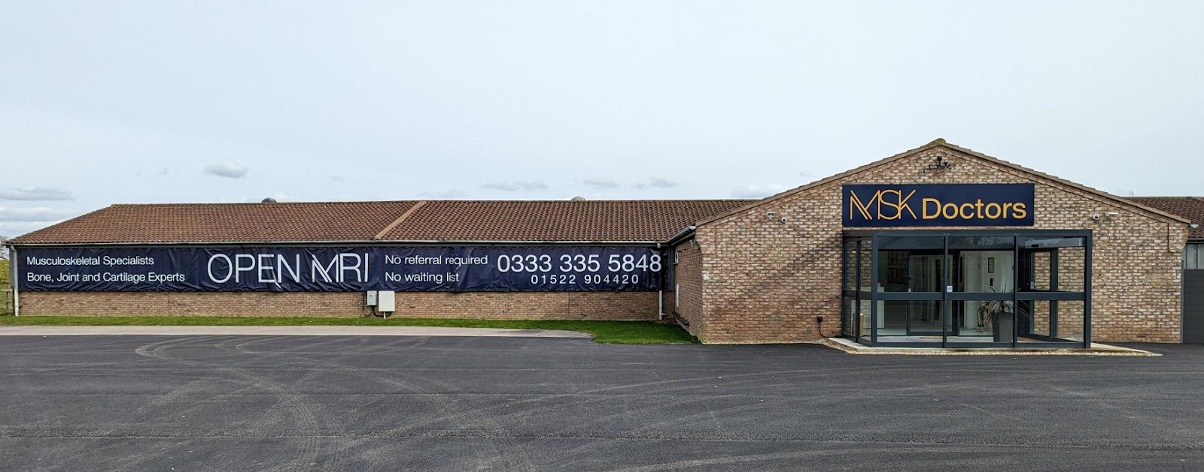Sesamoid Pain: Symptoms, Causes, Treatment & Exercises
:format(webp)/cdn.mskdoctors.com/storage/2025/4/ouz2KJG0HuFS4w1HBcydEmjPLNakMuCg.jpg)
Key Takeaways
-
Sesamoid pain is typically felt beneath the big toe and can be caused by repetitive stress or injury.
-
Common symptoms include swelling, bruising, and difficulty bending the big toe.
-
Rest, ice, and anti-inflammatory medications can help alleviate symptoms.
-
Custom orthotics and proper footwear can prevent further pain.
-
At MSK Doctors, we offer advanced diagnostic techniques and personalised treatment plans for sesamoid pain.
Understanding Sesamoid Pain

Sesamoid bones are located under the big toe. Image source: OrthoInfo
Sesamoid pain originates from the sesamoid bones, which are small, pea-shaped bones located under the big toe. These bones play a crucial role in providing balance and supporting weight-bearing activities.
When the sesamoid bones become inflamed or injured, it leads to a condition known as sesamoiditis.
Signs and Symptoms
-
Localised Pain Under the Ball of the Foot: Sharp, aching, or throbbing pain directly beneath the big toe joint, particularly when bearing weight or during push-off when walking.
-
Pain During Specific Movements: Discomfort that worsens when bending the big toe upward (dorsiflexion) or when attempting to rise on your toes.
-
Swelling and Tenderness: Visible inflammation, redness, and sensitivity to touch around the affected sesamoid area at the base of the big toe.
-
Pain Relief When Resting: Discomfort that typically diminishes when weight is removed from the foot and during periods of rest.
-
Difficulty Wearing Certain Footwear: Increased pain when wearing high-heeled shoes or footwear with inadequate cushioning under the ball of the foot.
Common Causes
There are many causes of sesamoid pain, but the most common is repetitive stress. Athletes are particularly susceptible to sesamoid pain due to the high-impact nature of their activities. Sports that involve running, jumping, or sudden changes in direction, like basketball or soccer, increase the risk of sesamoiditis.
The condition can significantly impact an athlete’s performance. It can limit their ability to train and compete, sometimes sidelining them for weeks or even months.

Athletes and dancers often experience sesamoid pain.
High heels and improper footwear can also contribute by placing excessive pressure on the forefoot. In some cases, a sudden injury - like a direct blow to the foot - can cause sesamoiditis. In addition, certain foot shapes, such as high arches, can predispose individuals to this condition because they naturally put more pressure on the balls of the feet.
Sesamoid Pain Treatment
Treating sesamoid pain effectively requires a combination of methods that focus on reducing inflammation and promoting healing. While rest and recovery are essential, there are other treatments that can expedite the process and alleviate discomfort.
Each person's recovery journey may vary, so it’s vital to listen to your body and adjust treatments as needed.
Medication Options
Over-the-counter medications can be a practical first step in managing sesamoid pain. Non-steroidal anti-inflammatory drugs (NSAIDs) like ibuprofen or naproxen can help reduce inflammation and relieve pain. However, these should be used as directed and not as a long-term solution.
In some cases, a doctor may recommend corticosteroid injections for more severe inflammation. This can provide significant relief, but it’s usually reserved for cases where other treatments haven’t been effective.
Rest and Recovery
Resting the foot is crucial in the early stages of sesamoiditis. Avoid activities that exacerbate the pain, such as running or jumping. Instead, opt for low-impact exercises like swimming or cycling to maintain fitness without putting stress on the feet.
Applying ice to the affected area can also help reduce swelling and numb the pain. Do this several times a day for 15-20 minutes, ensuring you wrap the ice pack in a cloth to prevent skin damage.
Use of Orthotics
Orthotics can provide much-needed support and cushioning for the foot, reducing pressure on the sesamoid bones. Custom orthotic inserts are often the best choice, as they are designed to fit the unique shape of your foot.
These inserts can be placed inside your shoes to help distribute weight more evenly and alleviate pain. It’s advisable to consult with a podiatrist to get the right fit and type of orthotic for your condition.
Tips For Athletes
-
Reduce training intensity if you notice symptoms.
-
Incorporate proper warm-up and cool-down routines.
-
Use supportive footwear designed for your specific sport.
Sesamoid Pain Relief Exercises
Foot Stretching Techniques
Stretching the foot regularly will relieve tension and improve flexibility. One effective technique is the toe stretch:
-
Sit comfortably and cross one leg over the other.
-
Use your hand to gently pull back on your big toe until you feel a stretch along the bottom of your foot.
-
Hold this position for 15-30 seconds and repeat on the other foot.
This stretch helps to relieve tension in the plantar fascia and the muscles surrounding the sesamoid bones.
Towel Scrunches
Towel scrunches are a simple exercise that can strengthen the small muscles in your feet. To perform this exercise:
-
Lay a towel flat on the floor and place your foot on it.
-
Use your toes to scrunch the towel towards you, hold for a moment, and then release.
-
Repeat this exercise 10-15 times on each foot.
Calf Strengthening
Strong calf muscles can help support the foot and reduce strain on the sesamoid bones. One effective exercise is the calf raise:
-
Stand with your feet hip-width apart and slowly rise onto the balls of your feet,
-
Lift your heels off the ground.
-
Hold for a few seconds before lowering back down.
-
Perform 10-15 repetitions, and repeat for 2-3 sets.
Prevention Strategies
Footwear Recommendations
Choose shoes that provide ample cushioning and support, especially in the arch and forefoot areas. Avoid high heels and shoes with narrow toe boxes, as they can increase pressure on the sesamoid bones.
Training Adjustments
If you’re an athlete or engage in regular physical activity, consider making adjustments to your training regimen. Gradually increase the intensity of your workouts to allow your body to adapt. Incorporate cross-training activities to reduce repetitive stress on your feet.
Switching between different types of exercises can help prevent overuse injuries and keep your training balanced.
Personalised Care at MSK Doctors
At MSK Doctors, we understand the impact that sesamoid pain can have on your daily life. Our team of experts is dedicated to providing personalised care for your specific needs.
We offer well-rounded assessments and customised treatment plans designed to address your unique condition and lifestyle. Our approach combines clinical expertise with a compassionate understanding of your experiences, ensuring you receive the best possible care.

For athletes or individuals who enjoy staying active alike, we're here to support you on your path to recovery and optimal foot health.
Ready to get back to optimal health and engage in your active lifestyle free from sesamoid pain? Book a consultation with MSK Doctors today.
Frequently Asked Questions (FAQ)
What are sesamoid bones?
Sesamoid bones are small, round bones embedded within tendons. In the foot, they are located beneath the big toe and help to absorb weight-bearing pressure, providing balance and support during movement.
How does sesamoid pain affect athletes?
For athletes, sesamoid pain can be particularly challenging as it affects their ability to perform at their best. The pain can limit participation in sports and training, requiring modifications to routines and sometimes leading to time off for recovery.
Can exercise prevent sesamoid pain?
Yes, exercises that focus on stretching and strengthening the muscles around the foot can help prevent sesamoid pain. These exercises improve flexibility, enhance support for the sesamoid bones, and reduce the risk of injury by maintaining overall foot health.
How quickly can I recover from sesamoiditis?
Recovery time from sesamoiditis can vary depending on the severity of the condition and the treatments employed. Mild cases may resolve within a few weeks with rest and conservative care, while more severe cases may take several months.
Why choose MSK Doctors for sesamoid pain?
At MSK Doctors, we offer expertise and compassionate care. Our personalised treatment plans are designed to meet the individual needs of each patient, ensuring effective management and relief.
:format(webp)/cdn.mskdoctors.com/storage/2025/5/hgH74n2NLXbN2EROC3N45aTdfUh1xKkM.jpg)
:format(webp)/cdn.mskdoctors.com/storage/2025/5/qf6zY2JVctL0BGJLEryU4lLIeRBsr5fC.jpg)
:format(webp)/cdn.mskdoctors.com/storage/2025/5/J26J2SuguZTzYNmqcI1EFk6a2wJsUF4a.jpg)
